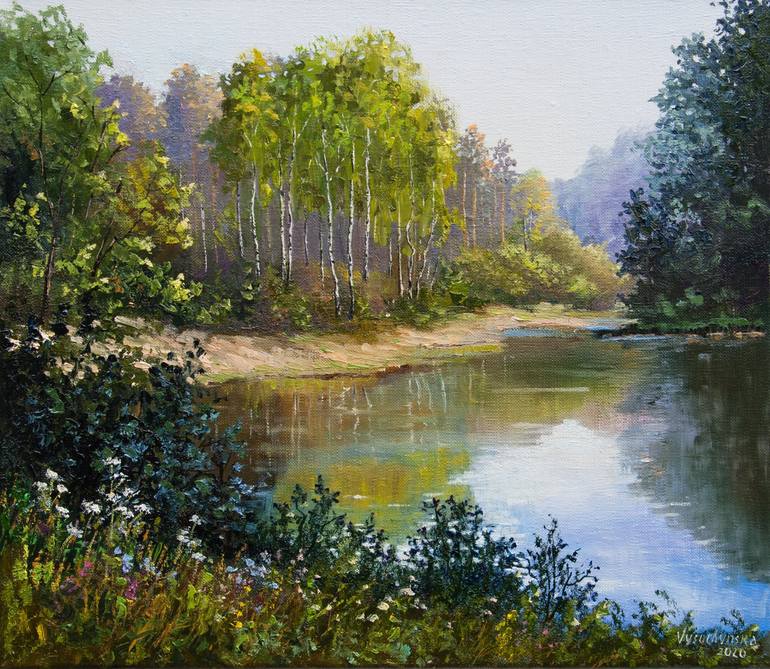Oil Paintings for Sale to Enhance Any Living Area
Oil Paintings for Sale to Enhance Any Living Area
Blog Article
Exploring Everything About Oil Paints: An Overview to Recognizing Their Beauty and Worth
Oil paintings have mesmerized audiences for centuries, offering a glimpse right into the artistic mastery of various periods. Their rich background is linked with ingenious methods and profound emotional expression. Comprehending the materials and approaches behind these art work can boost admiration. Furthermore, the market for oil paintings presents opportunities for collectors and financiers alike. As one discovers this remarkable globe, the question occurs: what makes an oil paint genuinely beneficial?
The History of Oil Painting: A Journey Via Time
Although oil painting has origins that go back to ancient times, it really prospered throughout the Renaissance, when artists found its adaptability and rich color capacity. Early examples can be mapped to the 7th century, with strategies advancing significantly throughout cultures. The medium came to be prominent in Northern Europe in the 15th century, particularly through the jobs of artists like Jan van Eyck, who pioneered its use for comprehensive realism and dynamic shades. This period noted a departure from tempera paints, enabling for better deepness and texture. As oil paint spread, it affected countless artists, resulting in masterpieces by renowned figures such as Leonardo da Vinci and Rembrandt. The medium's legacy proceeds, shaping the art globe well right into modern-day times.
Recognizing Oil Repaints: Products and Techniques
As artists check out the world of oil paints, they experience a varied selection of materials and techniques that specify this medium. The key parts of oil paint consist of pigments, which give shade, and drying oils, such as linseed, that bind the pigments and help with application. Different ingredients can customize the paint's appearance and drying out time, boosting versatility. Strategies like glazing, where transparent layers are accumulated, and impasto, which includes applying thick paint, permit various aesthetic effects. Furthermore, the usage of brushes, scheme blades, and even fingers can produce distinct textures and finishes. Comprehending these products and strategies allows musicians to totally share their creative thinking and attain the preferred effect in their artwork.
The Role of Color in Oil Paintings
Shade plays an essential duty in oil paints, influencing both visual allure and emotional vibration. Comprehending color theory essentials, including the relationships in between colors, can improve a musician's capability to convey state of mind and environment. Additionally, understanding color mixing techniques enables greater depth and richness in a painting's scheme.

Color Concept Essential
Understanding shade theory is important for musicians functioning with oil paints, as it creates the foundation for creating harmonious and aesthetically interesting make-ups. Color theory includes the research of how colors communicate, the shade wheel, and the relationships between main, secondary, and tertiary shades. Artists make use of corresponding shades to improve contrasts and produce prime focus, while comparable shades promote unity and cohesiveness within a piece. In addition, the concepts of cozy and amazing colors influence the understanding of deepness and room in a paint. Understanding these principles permits musicians to adjust shade successfully, assisting the viewer's eye and communicating their intended message. Proficiency of shade concept eventually enhances an artist's ability to share emotions and ideas through their job.
Psychological Impact of Shade
The emotional influence of color in oil paints plays a crucial duty in how audiences connect and regard with artwork. Shades evoke specific sensations and moods, influencing the viewer's mood. For example, warm colors like oranges and reds can develop a sense of heat and energy, while cool tones such as blues and environment-friendlies frequently stimulate calmness or self-questioning. Artists purposefully choose color combinations to enhance narrative aspects, leading the audience's psychological journey. The saturation and contrast of shades further magnify these results, attracting interest and creating emphasis. Inevitably, the interplay of colors in oil paints not just boosts their visual charm however also functions as a powerful medium for psychological expression, improving the visitor's experience and analysis.
Color Combining Techniques
While numerous aspects of oil paint contribute to the overall make-up, understanding color mixing techniques is essential for attaining desired impacts and deepness. Color mixing can be approached via different methods, including the subtractive and additive processes. Additive mixing involves incorporating colors of light, while subtractive mixing depends on pigments, where shades mix to create brand-new tones. Musicians often use a restricted combination to develop unified jobs, recognizing the connections between main, additional, and tertiary colors. Strategies such as glazing and scumbling further enhance deepness and luminance. By skillfully blending shades, an artist can evoke feelings, create centerpieces, and accomplish a sense of realism, inevitably raising the paint's emotional and visual effect.
Famous Oil Painters and Their Iconic Functions

Well known for their mastery of shade and strategy, oil painters have created some of the most well known artworks in history. Popular artists like Vincent van Gogh mesmerized target markets with his stirring brushwork in "Starry Night," while Claude Monet's "Impression, Daybreak" prepared for Impressionism. Leonardo da Vinci's "Mona Lisa" stays an enduring symbol of creative wizard, showcasing his skill in catching human expression. Meanwhile, Rembrandt's "The Evening Watch" highlights his cutting-edge usage of light and darkness. Other significant figures include Pablo Picasso, that transformed modern art with his strong trial and error in works like "Les Demoiselles d'Avignon," and Georgia O'Keeffe, whose lively representations of flowers and landscapes aided define American innovation. Each artist's one-of-a-kind design contributed significantly to the oil painting landscape.
Exactly how to Review the High Quality of an Oil Painting
Evaluating the quality of an oil paint involves a careful assessment of craftsmanship strategies, along with an analysis of shade and make-up. Observing brushwork, layering, and the application of paint can disclose the musician's skill degree. Furthermore, the interaction of shades and the overall setup of components contribute significantly to the painting's aesthetic value.
Evaluating Workmanship Techniques
A careful analysis of workmanship strategies is important for establishing the quality of an oil paint. Critics ought to first check out the application of paint; thick, distinctive brushstrokes might suggest a knowledgeable hand, while overly uniform applications could suggest a lack of depth. oil paintings for sale. The layering method is also important; the visibility of lusters and varied thickness can improve luminance and complexity. In addition, the quality of the products utilized, such as the canvas and pigments, plays a considerable duty in sturdiness and total visual. Interest to information in aspects like edges and changes between colors mirrors the musician's dedication to their craft. Eventually, these methods add to the paint's psychological effect and market price, functioning as signs of the musician's skill and intent
Analyzing Color and Structure
While evaluating the top quality of an oil painting, one have to concentrate on the interaction of color and composition, as these elements are fundamental to the artwork's overall impact. Shade options can develop and evoke emotions state of mind; consequently, the artist's scheme ought to be taken a look at for consistency and comparison. A well-balanced make-up guides the visitor's eye and creates a sense of unity. Artists commonly employ strategies like the guideline of thirds or leading lines to enhance aesthetic passion. Additionally, making use of light and darkness can add deepness, boosting the three-dimensionality of the painting. Eventually, a successful oil paint marries shade and structure, engaging the visitor and welcoming a deeper appreciation of the artist's vision and strategy.
Caring for and Preserving Oil Paintings
Appropriate treatment and conservation of oil paints is essential for keeping their honesty and longevity. To protect these art work, it is vital to present them far from direct sunshine, which can cause fading and discoloration. Keeping a stable environment with regulated temperature and humidity more aids in stopping damages. Cleaning must be done delicately utilizing a soft, completely dry fabric, avoiding any severe chemicals that could hurt the paint or varnish. Normal assessments for more info indications of degeneration, such as flaking or breaking, are a good idea. When storing or transporting oil paintings, proper extra padding and framework are necessary to avoid physical damage. Eventually, persistent care adds to the visual appeal and worth of oil paints with time.
The Marketplace for Oil Paints: Investing and gathering
Comprehending the marketplace characteristics for oil paintings is crucial for financiers and collection agencies alike. The worth of these artworks is affected by different variables, including the musician's online reputation, historical value, and current patterns. Collection agencies typically seek items that resonate personally while thinking about potential recognition in value. Auctions and galleries act as key places for purchasing and selling, with prices changing based on demand and rarity. Purchasing oil paints calls for research into the marketplace, in addition to an understanding of authenticity and provenance. In addition, arising artists might supply possibilities for significant returns, while established names can regulate high prices. Generally, a critical method to accumulating can generate both visual enjoyment and monetary benefits.

Regularly Asked Questions
What Are the Environmental Impacts of Oil Paint Materials?
The environmental influences of oil painting materials consist of the launch of unpredictable organic compounds (VOCs), damaging waste generation, and source removal for pigments. These elements add to air pollution and ecological destruction, elevating issues amongst eco mindful artists and consumers.
How Do Different Canvases Influence Oil Paint Outcomes?
Different canvases influence oil paint results substantially. Texture, absorbency, and surface area top quality can alter paint application, drying times, and shade vibrancy. Artists typically pick particular canvases to achieve preferred results and improve their creative expression.
Can Oil Paintings Be Brought Back if Harmed?
Oil paintings can certainly be brought back if harmed. Professional conservators use numerous techniques to fix splits, clean surface areas, and address discoloration, guaranteeing that the art work maintains its original elegance and value for future generations.
What Are the Indications of an Initial Oil Painting?
The indications of an initial oil painting consist of visible brush strokes, texture variations, and an irregular canvas weave (oil paintings for sale). In addition, authenticity might be confirmed with provenance, trademarks, and the existence of a varnish layer unique to oil mediums
Just How Has Modern Technology Influenced Modern Oil Paint Techniques?
Technology has actually considerably affected modern-day oil painting techniques by presenting electronic tools for planning, enhanced materials for texture and longevity, and on the internet platforms for offering and sharing art, therefore increasing artists' imaginative possibilities and audience get to. Oil paint has origins that date back to old times, it genuinely flourished throughout the Renaissance, when artists found its convenience and abundant shade possibility. The psychological impact of shade in oil paintings plays a vital duty in exactly how visitors link and regard with artwork. While lots of aspects of oil paint contribute to the overall composition, understanding shade blending methods is essential for attaining wanted impacts and deepness. Reviewing the top quality of an oil paint involves a mindful evaluation of craftsmanship methods, as well as an analysis of shade and make-up. While evaluating the high quality of an oil painting, one need to focus on the interplay of shade and composition, as these aspects are fundamental to the artwork's total influence.
Report this page